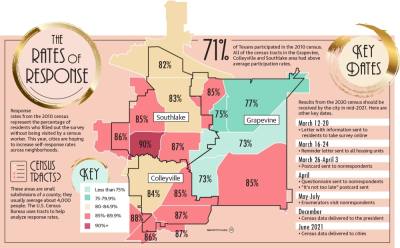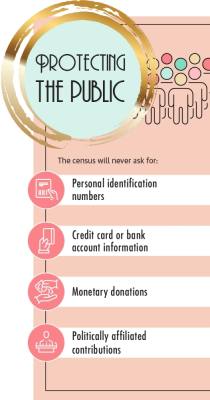The census takes place every 10 years and aims to count each person living in the United States, according to the U.S. Census Bureau. At the municipal level, the data determines legislative districts and the distribution of federal funds, among other items.
Historically, Southlake and Colleyville have had higher participation rates on the census as compared with neighboring Grapevine. The rate measures the percentage of households that filled out a census form without followup from a census worker.
Leaders from all three cities have partnered with the U.S. Census Bureau to increase awareness and participation on the census.
“With nearly $700 billion available in federal funding for schools, roadways, planning and funding for infrastructure, health care and more, the city of Grapevine benefits tremendously,” Grapevine Marketing and Communications Manager Mona Quintanilla said in an email. “It’s vitally important that everyone is counted.”
‘Money and power’
Each year, federal agencies rely on census data when distributing $675 billion to states, counties and municipalities. At the city level, an inaccurate count could lead to less federal funding to support services, such as transportation and public education.
Because of its size, Texas receives the third-most federal funding allocated through census data among states, according to the Texas Demographic Center. An undercount of the state’s population by just 1% could result in a $300 million loss in federal funds, according to the center.
Census data is also used to determine the number of congressional seats and electoral college votes each state has. This is especially important, as early estimates project Texas’ population growth could lead to a gain of three or four seats in the U.S. House of Representatives, according to county officials.
“Responding to the census is very important because it’s all about money and power,” said Bianca J. Gamez, the bureau’s senior media specialist for DFW and North Texas. “[Census data] helps create jobs. It helps provide housing, prepare for emergencies [and] build schools, roads and hospitals.”
Census data also helps inform the North Central Texas Council of Governments where grant funding needs to go, NCTCOG Senior Program Director Arash Mirzaei said. NCTCOG helps local governments in 16 counties, including Tarrant County, plan for common needs and development.
While federal funding and political seats are directly tied to the census, the official count affects local cities in more indirect ways, Mirzaei said. This includes assessing the transportation needs in Colleyville, Southlake or Grapevine. If vehicle trips are increasing, the highways and roadways in the area will receive more public money to help combat this, he said.
In addition, a new state law will rely for the first time on census data to calculate some funding for school districts. Census data will adjust a school district’s allotment to pay for certain programs and personnel, such as reading specialists or dyslexia teachers, according to Scott Wrehe, Carroll ISD’s assistant superintendent of financial services.
“If you participate [in the census], you will actually help your local area,” Mirzaei said.
Data from the 2010 census and subsequent population estimates were used when Tarrant County commissioners called for a bond in 2018 for the John Peter Smith Hospital district to make improvements for the projected growth of the county, according to Precinct 3 Commissioner Gary Fickes, whose precinct includes Grapevine, Colleyville and Southlake.
“The census helps us,” he said. “It’s a tool to help us to know where the growth is happening.”
Reaching hard-to-count populations
Certain socio-demographic groups are at a higher risk of being undercounted, according to the bureau. Members of hard-to-count communities include immigrants, college students, children under age 5, people who face language barriers, families who move frequently and people with mental or physical disabilities.
During the 2010 census, portions of Grapevine had some of the lowest self-participation rates in the area.
To help reach the city’s lower-participation areas, Quintanilla said the city is partnering with the Grapevine Relief and Community Exchange, or GRACE. Some GRACE clients live in neighborhoods with hard-to-count populations, GRACE Client Services Manager Marcela Melendez said in an email. A specialist with the U.S. Census Bureau trained GRACE case workers to help them inform clients of the upcoming census, she said.
“Our efforts at this time are to reach our individuals and families in our services and to help them know the importance of the census as well as the ease and confidentiality of it,” Melendez said in her email.
Sue Linder-Linsley, assistant census manager for the Dallas region, said it is important for people living in these areas to get hired as temporary census workers.
“We need neighbors knocking on neighbors’ doors,” she said.
What to expect
Residents will begin receiving mailed invitations to respond to the census between March 12-20, according to the bureau. Those who do not respond will receive several reminder postcards before being visited by a census worker between May and July, Linder-Linsley said.
For the first time, citizens will have the option to respond online in addition to by phone, by mail or in person.
“With the additional online and phone options, the census anticipates a larger self-response rate than ever before,” Linder-Linsley said.
However, some worry that the online option could alienate citizens without access to Wi-Fi. That is why the census is partnering with schools and libraries, including the Grapevine Public Library, to set aside computers for the public to complete the census online, Gamez said.
Grapevine, Colleyville and Southlake are all using resources, such as newsletters and social media, to educate residents about the importance of participating in the 2020 census.
“I think we will see a high participation rate,” Southlake Mayor Laura Hill said in an email. “I would love to see a 100% participation rate, but even if we push it up by one or two percentage points, I would be pleased.”







